Floods and Flooding in Iran:
There are ancient stories about floods and flooding in the Middle East according to the various narratives of holy books. Two rivers, the Euphrates and Tigris, flow through Mesopotamia, which is now the country of Iraq. There are several layers of exposed rocks near these two rivers in southeastern Mesopotamia (Iraq) that are likely flood deposits. Most are about a foot (0.3 m) thick, but one is as much as 3 meters thick. Flood debris from this same thick deposit along the Euphrates River, near the ancient Sumerian city of Shuruppak about 200 km southeast of Baghdad, has been dated by the C14 method, giving it an age of 2900 BCE. Flood deposits 2.4 meters thick are also reported as far northeast as the ancient Babylonian city of Kish (120 km south of Baghdad). At any rate, the many flood deposit layers show that flooding in southeastern Mesopotamia was not unusual in ancient times (1).
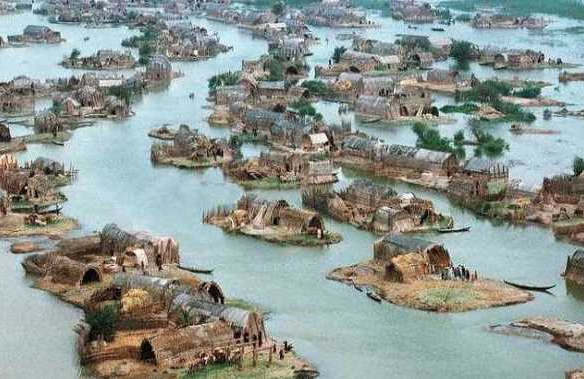
Floods are defined as a general and temporary condition of partial or complete inundation of normally dry land areas with overflow of inland or tidal waters from the unusual and rapid accumulation or runoff of surface waters from any source (2) or are caused by weather phenomena and events that deliver more precipitation to a drainage basin than can be readily absorbed or stored within the basin (3).

Floods are usually considered to be climatically controlled events, which in connection with topography and vegetation cover can be of considerable geomorphic significance (4). They may be caused either by intensive precipitation over small hilly watersheds or by heavy rains and thunderstorms in longer periods of time over large watersheds or as a result of the rapid melting of large snow masses in mountains. Floods are affected by various characteristics of the climatic system, most notably precipitation (intensity, duration, amount, timing, phase—rain or snow), but also temperature patterns (responsible for such phenomena as soil freezing, snow and ice melt, and ice jam formation). Floods are also affected by drainage basin conditions, such as pre-existing water levels in rivers, the snow and ice cover, the soil character and status (permeability, soil moisture content and its vertical distribution), the rate of urbanization, and the presence of dikes, dams, and reservoirs. River flooding may be concurrent with a storm surge or extreme tide events in areas close to sea level (5).
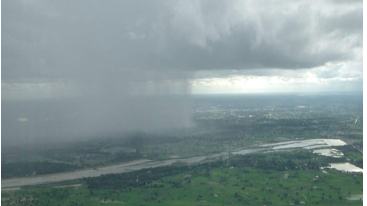
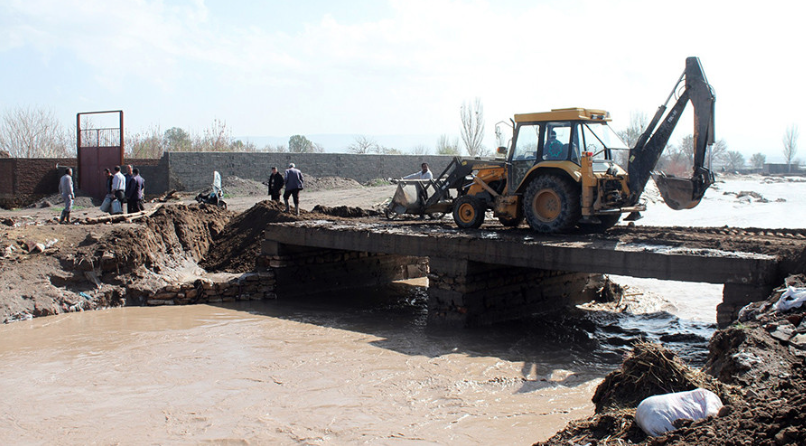
As water falls to the Earth in the form of rain or snow, it seeps into the ground. But if the ground is frozen, the surface impervious, or the soil is already saturated and cannot absorb the water faster than it falls from the sky, then problems arise. Severe flooding occurs by the combination of excessive heavy rainfall and snow melt, leading to extensive fluvial runoff. Floods cause sedimentation of flood plains, erosion, and other geomorphological relevant processes. Due to the fact that flood plains are the preferred locations of human settlements and agricultural activities, floods often cause the loss of human lives, as well as economic disasters (6, 7). Heavy temporary rainfalls, sometimes in combination with snow melt, are the prime causes of floods and flooding In Iran (8, 9).
There are various types of floods, according to a review of the large amount of available literature. A river flood occurs when the water levels rise over the top of the river banks due to excessive rain from a storm system making landfall, persistent thunderstorms over the same area for extended periods of time, combined rainfall and snowmelt, or an ice jam.
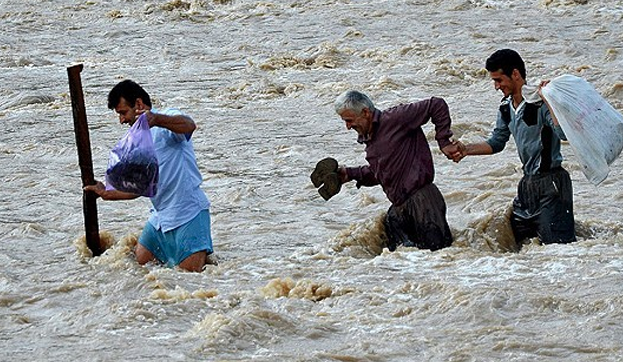
A coastal flood, or the inundation of land areas along the coast, is caused by higher than average tides and worsened by heavy rainfall and onshore winds (wind blowing landward from the ocean). Storm surge is an abnormal rise in the water level in coastal areas, over and above the regular astronomical tide, caused by forces generated from a severe storm’s wind, waves, and low atmospheric pressure. Storm surge is extremely dangerous, because it is capable of flooding large coastal areas. Extreme flooding can occur in coastal areas, particularly when the storm surge coincides with normal high tide, resulting in storm tides reaching up to 6 meters or more in some cases. Along the coast, storm surge is often the greatest threat to life and property from a hurricane. In the past, large death tolls have resulted from the rise of the ocean associated with many of the major hurricanes that have made landfall.
Inland flooding occurs when moderate precipitation accumulates over several days, intense precipitation falls over a short period, or a river overflows because of an ice or debris jam or dam or levee failure. A flash flood is caused by heavy or excessive rainfall in a short period of time, generally less than six hours. Flash floods are usually characterized by raging torrents after heavy rains that rip through river beds, urban streets, or mountain canyons, sweeping everything before them. They can occur within minutes or a few hours of excessive rainfall. They can also occur even if no rain has fallen. For instance, after a levee or dam has failed or after a sudden release of water by a debris or ice jam. Rainfall, that is normally not absorbed by vegetation, can run off almost instantly, causing creeks and drainage areas to flood much earlier and with higher magnitude than normal.
Factors that play a significant role in the intensity of floods are soil structure and texture. According to European researchers that conducted an investigation about the flood of 2000 in England, they reported that the exceptional combination of a wet spring and autumn provided the potential for soil structural degradation. Soils prone to structural degradation under five common lowland cropping systems (autumn-sown crops, late-harvested crops, field vegetables, orchards and sheep fattening and livestock rearing systems) were examined within four catchments that experienced serious flooding. Soil structural degradation of the soil surface, within the topsoil or at the topsoil/subsoil junction, was widespread in all five cropping systems, under a wide range of soil types and in all four catchments (10).
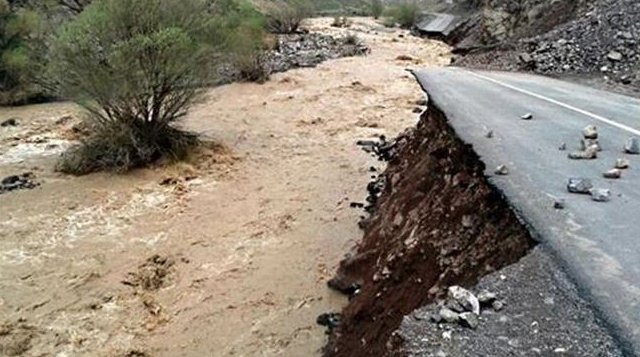
Factors Affecting Flood Frequency: There are two sets of factors influencing flooding (11). They are physical and anthropogenic.
Physical Factors:
• The size and shape of a river’s drainage basin dictates how much precipitation the river can receive and how quickly it will arrive (the lag time). A large drainage basin means that the river’s catchment area is large, so it will collect a lot of water and increasing discharge. The nature of the drainage basin has an influence on the likelihood of flooding. Some drainage basins are more likely to flood than others. Relief, vegetation, soil type, and geology all have a part to play. In areas of the world covered by dense forest, interception and uptake of water by plants reduce the risk of flooding during time of heavy rainfall. Another factor, which significantly affects the prevention of flood or to decrease its destructive nature, is the watershed area ground vegetation cover. Trees and plants intercept precipitation. If there is little vegetation in the drainage basin, then surface run-off will be high.
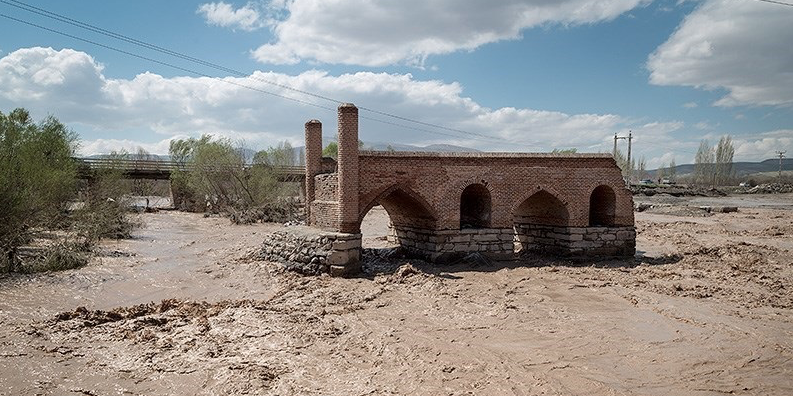
• The permeability of the soil and rock in a drainage basin is a big factor in flooding. If the basin’s soil is impermeable, because it has been saturated by previous rainfall or has been baked by prolonged drought or top soil is very compacted due to overgrazing, then any precipitation that falls won’t infiltrate and will instead run straight into the river’s tributaries, increasing the river’s discharge and triggering floods. Similarly, if the rocks in the area are non-porous or impermeable (such as granite or clay), then water won’t be able to infiltrate into the rocks and will again run straight off into the river increasing its discharge (12, 13, 14, 15).

• The vegetation cover in a basin will affect flooding. If a basin has very dense vegetation cover, the vegetation will intercept precipitation and store it, reducing the volume of water entering a river. Trees are one of the most important organisms that exist on planet Earth. Food for all living organisms originates from trees and other members in the plant kingdom. Every single organism depends directly or indirectly on trees for their survival. Trees not only provide food for other organisms, but also shelter and protection to many different types of organisms, including humans. In addition, trees also provide wood, shade, oxygen, and clean air. During heavy rains, trees reduce the risk of flooding. There are two major ways in which trees provide protection against flooding. Experts say that woodlands act as a barrier to floodwater, while trees also prevent soil erosion, reducing sediment going into rivers, and increasing water absorption into the ground. This slows rainwater running off into swollen streams and helps lower peak flood levels. When plants grow in an area, the roots of plants dig deep in to the soil and create space between soil particles. When it rains in the highlands, water that flows downhill gets drained into the space created by the root system of plants. Due to this, the chance of flooding is greatly reduced (16, 17, 18).
Conversely, if a basin is sparsely vegetated, then there will be no interception and so more water will enter a river. Vegetation helps bind soil too. With no vegetation, the soil is highly susceptible to mass wasting, which can cause large volumes of soil to enter a river and reduce the river’s capacity. When plants are absent, especially in rocky areas, rocks prevent water from seeping into the ground (19, 20, 21, 22).
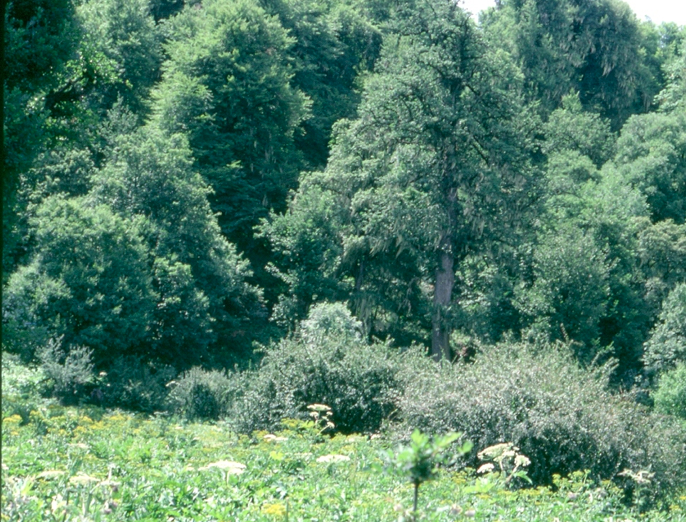
• The relief and steepness of the basin affects how quickly water enters a river and so how likely a river will be flood. If the river’s valley has steep sides, water will quickly enter a river, increasing the river’s discharge. This phenomenon is also observed in paved roads, since there is no room for water to seep in. When a layer of water runs off a rocky surface, it reduces friction and the following layers of water will run more freely as there is less friction. If more water is dumped into rivers and lakes than they can handle, these water bodies tend to overflow and the banks burst and cause flooding. If there are more trees in an area, the root system of trees can create space between these rocks, hence reducing the amount of water being dumped into lakes and rivers (23, 24, 25).

• The number of tributaries flowing into a river affects the likelihood of floods. If a river has a lot of tributaries, the river’s discharge will be much higher, because lots of water will be entering it from its tributaries. After heavy precipitation, the discharge will rise even more and floods are likely, especially at confluences (where a tributary meets the river) as this is where discharge is highest (26).
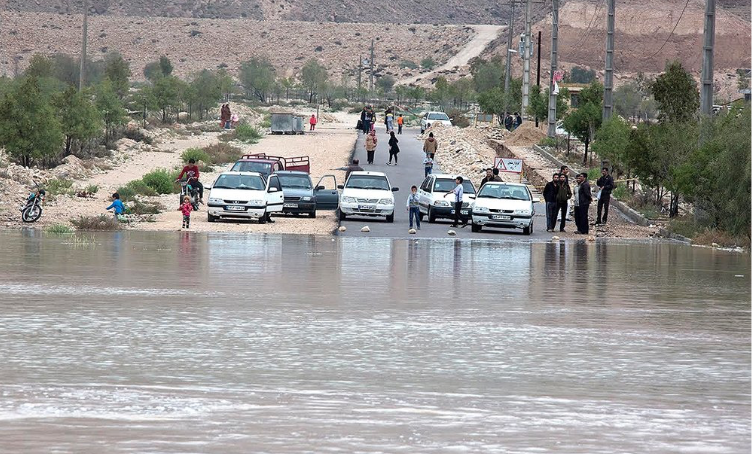
Human (anthropogenic) Factors:
• If a river’s drainage basin or floodplain has been heavily urbanized, a river becomes much more prone to flooding. Urbanization generally involves the laying down of tarmac of concrete, impermeable substances that will increase surface runoff into the river, and therefore, increase the river’s discharge (27, 28, 29, 30).
• Urbanization often involves deforestation. This obviously reduces vegetation cover, reducing infiltration, and increasing surface runoff into a river (31, 32). With human intervention and occupancy, there is a need for better understanding of the forest/water interaction and floodplain.
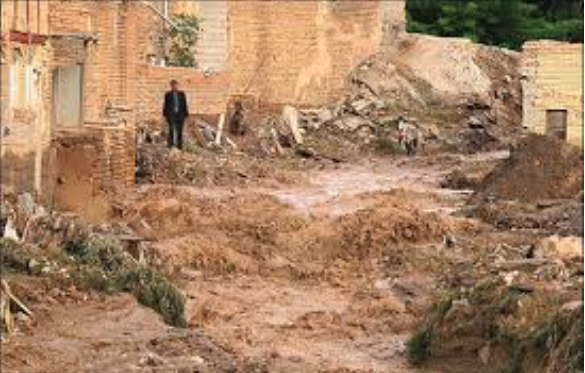
• To stop roads and streets from flooding, humans will often build storm drains that collect rainwater and channels it into a river or stream. Man will often send this water to the local river or stream, so although roads and streets won’t be flooded by rainwater, the entire town will be, as rainwater enters the river much faster than it would without the storm drains. When land is paved over or covered by roads and roofs, it is like putting “Plastic Wrap” on top of the ground. Rain, that would have soaked into the ground and recharged the groundwater, now runs across the surface creating “storm water run-off” which must be collected, conveyed, and discharged to a receiving body, typically rivers. As more water is running off the earth than soaking into it, increased flows would cause flooding and overwhelm our rivers with pollutants, which make our waterways unsafe for fish and too toxic to drink. Trees put holes into this “Plastic Wrap” and allow rain to infiltrate into the ground and recharge groundwater, rather than running off the surface. The influence of forests and forest alteration on water yield and timing is very complex and must be researched.
Climate change is a physical factor that could potentially be a human factor as well. Changes in the climate mean that certain areas are going to experience more frequent and more intense storms that can lead to large flooding. While climate change is definitely happening, whether this is a human factor is certainly debatable. We’re probably not helping, but keep in mind that the planet’s climate would be changing regardless of humanity’s existence (33, 34).
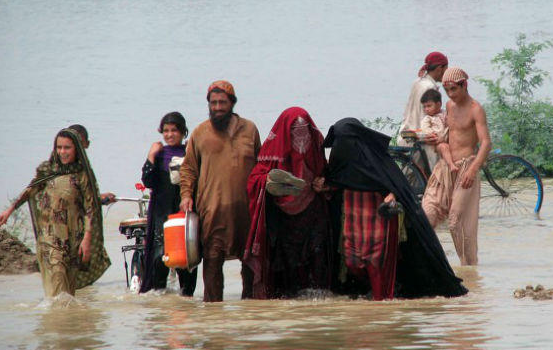
Purpose and Benefits of Flood Control:
The overall purpose of flood-control structures is to eliminate high and low water periods and create uniform, manageable water regimes (35, 36). As mentioned earlier, forests were the original land covers. Their protective effects consist of maintaining the ‘natural’ flow regime, which inevitably consisted of both flooding and low flows to which stream channels and associated biota were adjusted. Healthy forests and wetland systems provide a host of watershed services, including water purification, ground water and surface flow regulation, erosion control, and stream bank stabilization. The importance of these watershed services will only increase as water quality becomes a critical issue around the globe. Their financial value becomes particularly apparent when the costs of protecting an ecosystem for improved water quality are compared with investments in new or improved infrastructure, such as purification plants and flood control structures. In many cases, it is often cheaper and more efficient to invest in ecosystem management and protection (16,17,18).

Flooding causes a variety of problems ranging from the short term, and more immediately evident risks, to long term risks (37). Immediate risks are often the greatest danger in terms of risk to human life. According to the world health organization (38), floods greatly increase the risk of the spread of communicable diseases. Water-borne diseases, such as typhoid fever and cholera, are likely to spread during flooding due to possible contamination of water supplies, especially if the floodwater becomes contaminated with sewerage. Vector borne diseases are those spread by carriers. For example, floods can lead to a large increase in the habitat of mosquitoes, which are spreaders of malaria. The sheer mass of water causes risks to anyone trapped in the affected area, from bursting gas pipes, collapsing structures, and drowning (39).
The long term risks of flooding are in the form of millions of dollars in damage to buildings, infrastructures, and people’s livelihoods. After a major flood, economic instability is likely to follow, loss of business, damage to stock, and even loss of tourism income. Some countries, which have been devastated by floods, may suffer the consequences for a long time after the water has subsided. Food supplies are being destroyed and other economic losses may lead to widespread poverty and famine. Hence, the control of floods and management of those natural disasters are absolutely essential to the well-being of any community (40, 41).
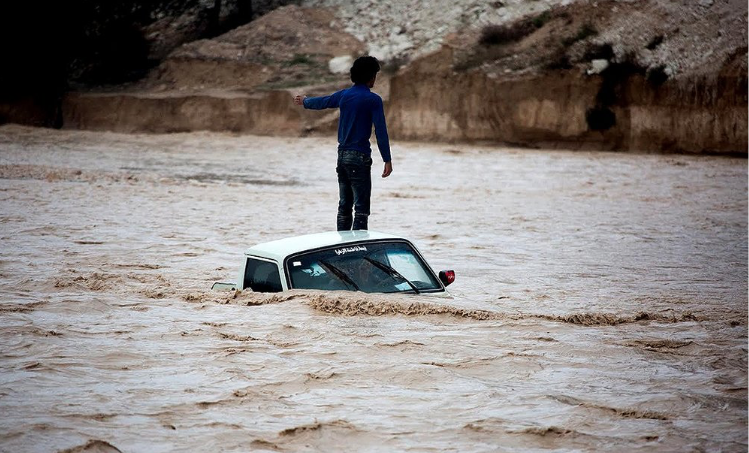
Flood Prevention:
Over the centuries, many countries have developed prevention systems and placed different measures to control flood damage to limit the effects of heavy or seasonal rains and tides, as well as tropical storms. There are two main systems closely connected to one another. One is concerned with preventing or limiting their effects. The other is concerned with predicting when, how often, and how severely floods will strike. Those invented measures are as following:
Reservoirs:
A reservoir can be described as “a natural or artificial lake for storing water for community use”. Reservoirs can be considered a useful form of flood control, especially in areas of irregular rain patterns, such as high rainfall in some seasons followed by periods of drought. This way, water can be stored during periods of rainfall and then released or used in the community over a longer period of time (42, 43, 44).
Dams:
Dams are structures designed by humans to capture water and modify the magnitude and timing of its movement downstream (46). Dams are structures spanned across rivers. The gates are used to slow or increase the rate of flow through the dam for the purpose of controlling the water flow as well as generating large amounts of electricity.
Dams are often considered as part of a reservoir system as well. Their advantages make them able to act as more than just a flood defense. However, there are many negative effects reported about construction of dams too (47, 48). They are considered good sources for hydroelectric power stations. Dams, if improperly built, increases flood risk as they can fail for any reason (49, 50).
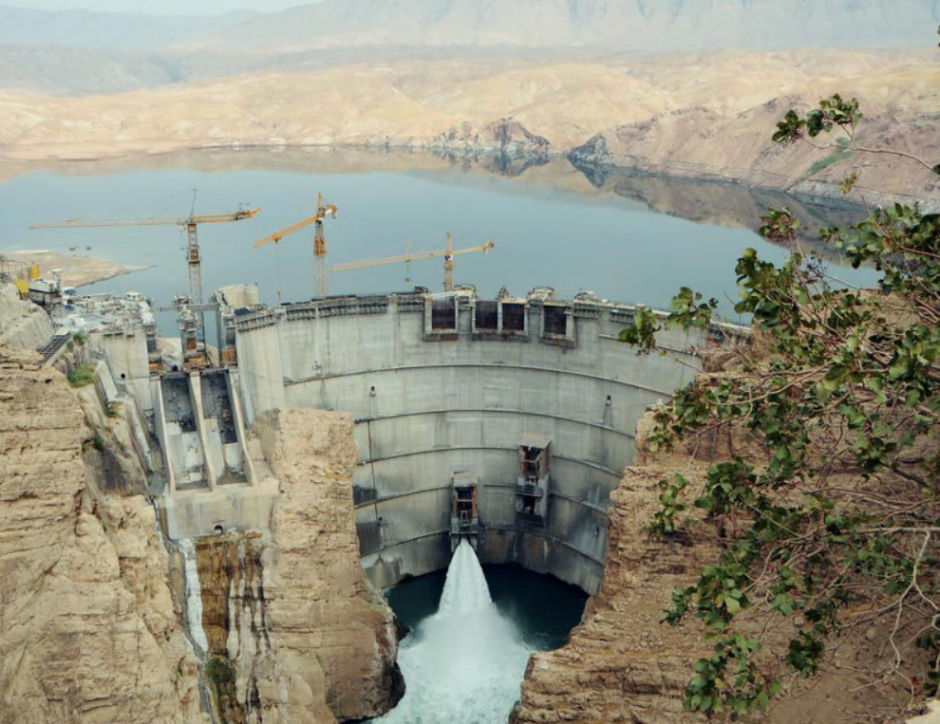
Storm drains:
Storm drains are systems that are designed to drain rainwater from roofs, paved areas, and roads. They generally consist of a series of underground pipes that lead into catchments. These drain pipes are usually made with a small angled runway that makes sure water does not remain stagnant, instead it would run off into catchments (51). These systems are essential in urban areas, as rainwater is not able easily to penetrate paved areas. Otherwise, it would cause regular flooding of urbanized areas (52). The urban municipalities usually place grids on these drainage holes to prevent large objects from falling into them, although quite large holes to prevent them from becoming blocked. As a result of sediment accumulation trapped in these run ways, they require regular maintenance, especially during the autumn season when leaves and loose soil are likely to be washed into them (53, 54).
Management of Floodplains:
A floodplain is defined as a flat or nearly flat land adjacent to a stream or river that experiences occasional flooding. This land may, because of its proximity to fresh water, be very fertile and suitable for other uses, but control and awareness of developments and usage of these pieces of land are essential for the safety of those living around these areas (55). Steps must be taken and evacuation plans put in place to prevent a great loss of life or possessions during massive floods in such areas (56).
It is usually done by the construction of levees, walls or sloped compacted soil beds. For storm floods, most studies focused on flood disasters, forecasting flood risk, and efficiency and floodwater utilization, which has been extended such that a rain-flood can be one of the main recharge sources for groundwater in some regions. Despite the disaster of floods, under positive circumstances, flood water can be used to constitute a considerable amount of a region’s water resources, especially in a groundwater system. It has been reported that inundated floodplains always had high recharge rates for shallow groundwater (57).
Although floods are often hazardous to human life and the environment (e.g., soil erosion, inundation of lands, and swamping caused by the groundwater level rising) they can be one of the main recharge sources for groundwater in some regions, especially for shallow groundwater (58).
To respond to the growing groundwater crisis and take advantage of the high levels of runoff not captured by natural recharge, augmentation of groundwater resources through artificial recharge of aquifers has become widespread in India over the last 3–4 decades. In fact, the growth in the use of artificial recharge has expanded to such an extent that it can be called a “groundwater recharge movement”, which has behind it both secular and spiritual proponents. This recent movement builds on artificial groundwater recharge concepts that have been practiced from time immemorial in the hard-rock, semi-arid regions of south- and north-western India (59). This movement is becoming prevalent around the world in arid and semiarid regions. Recently, a US water expert has defined it as the process of collecting natural precipitation from a prepared watershed for beneficial use. Nowadays, water harvesting has become a general term for collecting and storing runoff water or creek flow, resulting from rain in soil profile and reservoirs, both over surface /under surface. Previously, this was used for arid and semi-arid areas, but recently their use has been extended to sub-humid and humid regions too (60). This method was continually used by the past generation of Iranians, but it is not popular these days. This is all due to lack of proper water management in Iran.
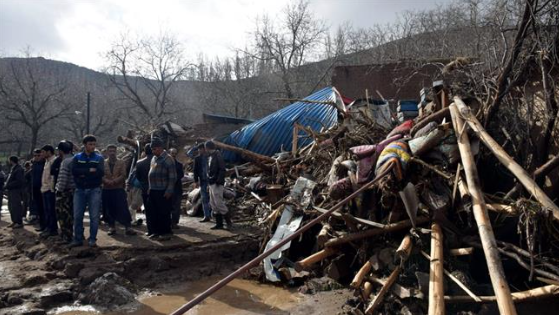
Environmental Agencies:
In the west and countries with solid democracies, one of the functions of environmental agencies are to issue flood maps, which consist of areas with flood risks and assessments for the whole country. Anyone can request copies of these maps or simply view them online (61). They outline which parts of the country are at risk of flooding, to what degree, and from what source. In addition, there is a requirement that whenever any landscaping changes or construction works are to be done, a strict risk assessment must be conducted in that area; not only on the area being developed, but also on the effect that this development would have on the surrounding area and whether it would increase the flood risk of that area (62). The development should not interfere with the drainage system of the surrounding area (63). However, due to a corrupt governing process, all these actions are missing in Iran.
Meteorological Predictions:
Meteorological predications are powerful tools that assist authorities to take an on-time action in flood control. The scientists dealing with these issues devote their entire careers to understanding and predicting the way weather will act. They make use of the obtained data of air pressure, air temperature, weather balloons and, in more recent years, weather satellites to predict weather patterns (65). These organizations are essential and one of the frontier lines as far as flood defense goes. They provide data for the engineers to build upon, they also provide the data for certain emergency systems to run, evacuation of high risk areas, and the protection of flood barriers (66, 67). One of the most essential qualities of such organizations are making reliable and clear predictions ahead of time, then communicating with the necessary authorities and making sure what needs to be done is carried out (65). Frequency based risk assessment is a process used by meteorologists to provide estimations for governments, engineers, and insurance companies alike. These analyses and risk assessments are rather vital, as it provides engineers and designers with a template to design other flood defenses (68, 69). Without this data, we would simply be building walls and would have no idea how high they need to be and how likely it would be a sufficient or effective flood defense. It also sometimes hints on patterns of likelihood on when a flood would occur. These tools and resources are also available in Iran, but never are they put these to work for any risk assessment in Iran. One must mention that all these estimations would become more and more unreliable as sea levels rise, changes climate patterns come more often, and weather patterns becomes more unpredictable.
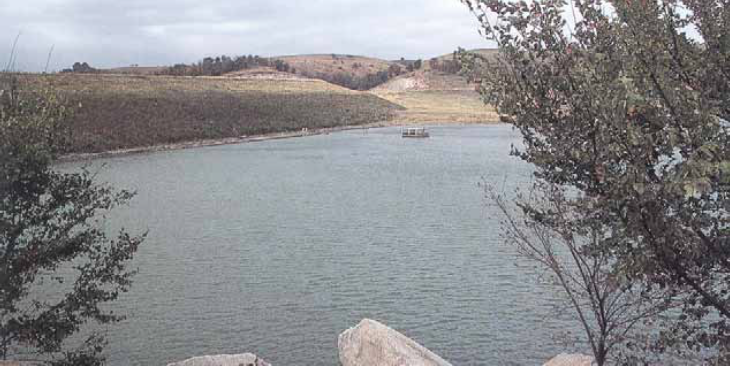
Conclusions:
Floods are unavoidable natural phenomena caused by large surges of water in a short period of time, making the established drainage system unable to handle it. Floods are the most frequent form of natural disasters and among the costliest to both human life and property. Worldwide, the economic damage from flooding has been substantial.
Flooding in Thailand in 2011 cost an estimated $40 billion, and flooding in China in 1998 cost an estimated $30 billion. Other floods in the United States, Korea, Pakistan, and Germany, between 1998 and 2011, cost between $9.5 and $18 billion. According to National Weather Service data, U.S. floods have cost between $0.5 billion and $56 billion every year since 1903, averaging $5.4 billion. Deaths attributable to these floods have averaged around 100 per year.
Concerns about growing coastal flood risk have led to multiple studies of potential damages at port cities throughout the world. One study estimated that as of 2005, about 40 million people across 136 port cities were exposed to a 1 in 100-year coastal flood event. The total value of assets associated with this exposure was calculated at US $3,000 billion. Sixty-five percent of the population exposed to this risk are located in Asia. North America accounts for about 21 percent, while South America accounts for under 2 percent and Australasia accounts for less than 1%. The distribution of assets at risk is different, reflecting greater development in North America, which represents about 50 percent of total assets (70). There is no estimated flood related damage in Iran. According to unofficial reports, the annual damage cost is $2-3 billion and casualties of 80-100 people.
Therefore, man has to do everything to limit the damages caused by these floods and ensures that the livelihood of the people in the community is protected. Regardless, if one believes the climate change is due to human negligence or it is simply part of longer universal cycle of changes, one must take steps to prepare for the worse.
Man has all the possible tools in his possession to perform forecasts and predictions, however, due to nature’s complexities and the integration of various natural factors, these might fail. Even the defenses that man puts in place might fail or turn out to be not very effective, but man must not stop trying. Furthermore, the more communities invest in a green economy, such as afforestation, new plantings, and protection of ground cover vegetation, they will have more success in flood control and consequently improve water resources. A specialized trained work force is extremely important for risk evaluation of flood zones, consisting of engineers and ecosystems specialists, in order to perform research, make appropriate decisions, implement Eco-friendly tasks, and have command of the subject areas in all times. This is very beneficial to all communities, providing not only security for the nation, but also economic stability.
1. https://ncse.com/library- resource/yes-noahs-flood-may- have-happened-not-over-whole- earth
2. http://www.ga.gov.au/ scientific-topics/hazards/ flood/basics/what
3. https://ks.water.usgs.gov/ flood-definitions
4. V. Iacobellis, P. Claps, M. Fiorentino. Climatic control on the variability of flood distribution. Hydrology and Earth System Sciences Discussions, European Geosciences Union, 2002, 6 (2), pp.229-238.
5. Kundzewicz, Z.W., et al., 2013. Flood risk and climate change: global and regional perspectives. Hydrological Sciences Journal, 59 (1), 1–28.
6. http://climate-adapt.eea. europa.eu/metadata/case- studies/realisation-of-flood- protection-measures-for-the- city-of-prague
7. https://www.ncbi.nlm.nih.gov/ pmc/articles/PMC3644295/
8. http://www.tehrantimes.com/ news/411199/Devastating-flood- hits-southern-Iran
9. http://reliefweb.int/report/ iran-islamic-republic/deadly- flash-floods-iran-claim-least- 42-lives
10 I. P. Holman, J. M. Hollis, M. E. Bramley, T. R. E. Thompson. The contribution of soil structural degradation to catchment flooding: a preliminary investigation of the 2000 floods in England and Wales. Hydrology and Earth System Sciences Discussions, European Geosciences Union, 2003, 7 (5), pp.755-766. <hal-00304928>
11. https://geographyas.info/ rivers/flooding/
12. David A. Lavers et al, 2011. Winter floods in Britain are connected to atmospheric rivers. Geophysical Research, Vol. 38 (23):1-8.
13. Felix Naef et al, 2002. A process based assessment of the potential to reduce flood runoff by land use change. Journal of Hydrology, 267; 74-79.
14. A. Gioia, V. Iacobellis, S. Manfreda, and M. Fiorentino, 2008. Runoff thresholds in derived flood frequency distributions. Hydrol. Earth Syst. Sci., 12, 1295–1307.
15. Gebhard Schüler, 2006. Identification of flood-generating forest areas and forestry measures for water retention For. Snow Landsc. Res. 80,1: 99–114.
16. Marcelo Henrique Ongaro Pinheiro et al. 2015. Consequences of suppressing natural vegetation in drainage areas for freshwater ecosystem conservation: considerations on the new “Brazilian forest code”. Acta Botanica Brasilica 29(2): 262-269.
17. Strayer, D., Beighley, R., Thompson, L. et al, 2003. Effects of Land Cover on Stream Ecosystems: Roles of Empirical Models and Scaling Issues. Ecosystems, 6: 407.
18. Kai. M. A. Chan et al, 2006. Conservation Planning for Ecosystem Services. Plos Biology, Vol. 4 (11) 2138-2152.
19. Durán Zuazo, V.H. & Rodríguez Pleguezuelo, C.R. 2008. Soil-erosion and runoff prevention by plant covers. A review Agron. Sustain. Dev. 28, 1. doi:10.1051/agro:2007062.
20. Sandra Díaz*, Joseph Fargione, F. Stuart Chapin III, David Tilman, 2006. Biodiversity Loss Threatens Human Well-Being. Plos Biology, Vol. 4, 8 (277): 1300-1305.
21. COREY J. A. BRADSHAW, NAVJOT S. SODHI, KELVIN S.-H. PEH, BARRY W. BROOK, 2007. Global evidence that deforestation amplifies flood risk and severity in the developing world. Global Change Biology, Vol. 13 (11): 2379–2395.
22. Hong, Y., Adler, R.F., Negri, A. et al, 2007. Flood and landslide applications of near real-time satellite rainfall products. Nat Hazards, 43 (2): 285 294.
23. Istanbulluoglu, E., and R. L. Bras (2005), Vegetation-modulated landscape evolution: Effects of vegetation on landscape processes, drainage density, and topography, J. Geophys. Res., 110, F02012, doi:10.1029/2004JF000249.
24. B. Y. Liu, M. A. Nearing, P. J. Shi and Z. W. Jia, 1999. Slope Length Effects on Soil Loss for Steep Slopes. Soil Science Society of America Journal, Vol. 64 No. 5:1759-1763.
25. https://oup.silverchair-cdn. com/oup/backfile/Content_ public/Journal/bioscience/48/ 9/10.2307/1313331/2/48-9-681. pdf?
26. Pattison, I., S. N. Lane, R. J. Hardy, and S. M. Reaney (2014), The role of tributary relative timing and sequencing in controlling large floods, Water Resour. Res., 50, 5444–5458, doi:10.1002/2013WR014067.
27. Hollis, G. E. (1975), The effect of urbanization on floods of different recurrence interval, Water Resour. Res., 11(3), 431–435, doi:10.1029/WR011i003p00431.
28. Booth, D. B. (1990), STREAM-CHANNEL INCISION FOLLOWING DRAINAGE-BASIN URBANIZATION1. JAWRA Journal of the American Water Resources Association, 26: 407–417. doi:10.1111/j.1752-1688.1990. tb01380.
29. Booth, D. B. and Jackson, C. R. (1997), URBANIZATION OF AQUATIC SYSTEMS: DEGRADATION THRESHOLDS, STORMWATER DETECTION, AND THE LIMITS OF MITIGATION1. JAWRA Journal of the American Water Resources Association, 33: 1077–1090. doi:10.1111/j.1752-1688.1997. tb04126.
30. S. Suriya, B.V. Mudgal, 2012, Impact of urbanization on flooding: The Thirusoolam sub watershed – A case study. Journal of Hydrology 412–413, 210–219.
31. Arne Tollan 2002, Land-use change and floods: what do we need most, research or management? Vol. 45(8): 183-190.
32. Van DIJK, A. I. J. M., Van NOORDWIJK, M., CALDER, I. R., BRUIJNZEEL, S. L. A., SCHELLEKENS, J. and CHAPPELL, N. A. (2009), Forest–flood relation still tenuous – comment on ‘Global evidence that deforestation amplifies flood risk and severity in the developing world’ by C. J. A. Bradshaw, N.S. Sodi, K. S.-H. Peh and B.W. Brook. Global Change Biology, 15: 110–115. doi:10.1111/j.1365-2486.2008. 01708.
33. Colleen L. Lau, Lee D. Smythe, Scott B. Craig, Philip Weinstein; Climate change, flooding, urbanisation and leptospirosis: fuelling the fire?. Trans R Soc Trop Med Hyg 2010; 104 (10): 631-638. doi: 10.1016/j.trstmh.2010.07.002.
34. Chang, H. and Franczyk, J. (2008), Climate Change, Land-Use Change, and Floods: Toward an Integrated Assessment. Geography Compass, 2: 1549–1579. doi:10.1111/j.1749-8198.2008. 00136.
35. http://www.nat-hazards-earth- syst-sci.net/14/135/2014/ nhess-14-135-2014.pdf.
36. http://scholarship.law.duke. edu/cgi/viewcontent.cgi article=1241&context=delpf
37. http://www.chiefscientist.qld. gov.au/publications/ understanding-floods/flood- consequences.
38. http://www.euro.who.int/__ data/assets/pdf_file/0020/ 189020/e96853.pdf
39. http://www.ssi.dk/~/media/ Indhold/DK%20-%20dansk/ Smitteberedskab/ Infektionshygiejne/Vandskade/ Health%20risks%20and% 20hazards%20caused%20by% 20floods.ashx
40. Doocy S, Daniels A, Murray S, Kirsch TD. The Human Impact of Floods: a Historical Review of Events 1980-2009 and Systematic Literature Review. PLOS Currents Disasters. 2013 Apr 16 . Edition 1. doi: 10.1371/currents.dis. f4deb457904936b07c09daa98ee817 1a.
41. https://www.nature.com/ articles/srep36021
42. https://pdfs.semanticscholar. org/612c/ b57ddaf37ec314ba483f5e28844663 c26583.pdf
43. R. M. Baxter, 1977. Environmental Effects of Dams and Impoundments. Ann. Rev. Ecol. Sys. 8:255-283.
44. Ma, W., Huang, T., Li, X., Zhou, Z., Li, Y., & Zeng, K. (2015). The Effects of Storm Runoff on Water Quality and the Coping Strategy of a Deep Canyon-Shaped Source Water Reservoir in China. International Journal of Environmental Research and Public Health, 12(7), 7839–7855. http://doi.org/10.3390/ ijerph120707839.
45. Schwanenberg, D., Fan, F.M., Naumann, S. et al. Water Resour Manage (2015) 29: 1635. doi:10.1007/s11269-014-0899-1.
46. N. Leroy Poff, David D. Hart; How Dams Vary and Why It Matters for the Emerging Science of Dam Removal: An ecological classification of dams is needed to characterize how the tremendous variation in the size, operational mode, age, and number of dams in a river basin influences the potential for restoring regulated rivers via dam removal. BioScience 2002; 52 (8): 659-668. doi: 10.1641/0006-3568(2002)052[ 0659:HDVAWI]2.0.CO;2.
47. Phillip M. Marren et al, 2014. The Potential for Dams to Impact Lowland Meandering River Floodplain Geomorphology. The Scientific World Journal, Volume 2014, Article ID 309673, 24 pages http://dx.doi.org/10.1155/ 2014/309673.
48. Kirchherr, J. & Charles, K.J., 2016. The social impacts of dams: A new framework for scholarly analysis. Environmental Impact Assessment Review. Available at: http://www.sciencedirect.com/ science/article/pii/ S0195925515300330.
49. Qicai Lin, 2011, Influence of Dams on River Ecosystem and Its Countermeasures. Journal of Water Resource and Protection, 3, 60-66.
50. Chiyuan Miao, Alistair G. L. Borthwick, Honghu Liu and Jigen Liu, 2015. China’s Policy on Dams at the Crossroads: Removal or Further Construction? Water 7, 2349-2357; doi:10.3390/w7052349.
51. Walsh CJ, Fletcher TD, Burns MJ (2012) Urban Stormwater Runoff: A New Class of Environmental Flow Problem. PLoS ONE 7(9): e45814. doi:10.1371/ journal.pone.0045814.
52. http://theconversation.com/ stormwater-innovations-mean- cities-dont-just-flush- rainwater-down-the-drain-40129 .
53. Qianqian Zhou, 2014. A Review of Sustainable Urban Drainage Systems Considering the Climate Change and Urbanization Impacts.Water 6(4), 976-992; doi:10.3390/w6040976.
54. Dagnachew Adugna Belete, 2011. Road and urban storm water drainage network integration in Addis Ababa: Addis Ketema Sub-city. Journal of Engineering and Technology Research Vol. 3(7) 217-225.
55. Boudaghpour et al, 2014. Estimation of flood environmental effects using flood zone mapping techniques in Halilrood Kerman, Iran. Journal of Environmental Health Science & Engineering,12:153 DOI 10.1186/s40201-014-0153-z.
56. ShahiriParsa et al. Floodplain Zoning Simulation by Using hec-rAS and cche2d Models in the Sungai Maka river. Air, Soil and Water Research 2016:9 55–62 doi:10.4137/ASWr.S36089.
57. Yuyu Liu et al, 2016. Assessment of Shallow Groundwater Recharge from Extreme Rainfalls in the Sanjiang Plain, Northeast China.Water, 8, 440; doi:10.3390/w8100440.
58. Xihua Wang, Guangxin Zhang and Yi Jun Xu, 2015. Impacts of the 2013 Extreme Flood in Northeast China on Regional Groundwater Depth and Quality,Water, 7(8): 4575-4592; doi:10.3390/w7084575
59. http://www.iwmi.cgiar.org/ Publications/CABI_ Publications/CA_CABI_Series/ Ground_Water/protected/ Giordano_1845931726-Chapter10. pdf
60. http://portal.unesco.org/ geography/fr/files/6192/ 11690988831Accepted_Papers_-_ 1.pdf/Accepted%2BPapers%2B-% 2B1.pdf
61. http://www.kcl.ac.uk/sspp/ departments/geography/people/ academic/demeritt/ PORTERandDEMERITT.pdf
62. James Porter, David Demeritt, 2012. Flood-Risk Management, Mapping, and Planning: The Institutional Politics of Decision Support in England, Environment and Planning A, Vol 44, Issue 10, pp. 2359 – 2378.
63. Maantay, J., & Maroko, A. (2009). Mapping Urban Risk: Flood Hazards, Race, & Environmental Justice In New York”. Applied Geography (Sevenoaks, England), 29(1), 111–124. http://doi.org/10.1016/j. apgeog.2008.08.002.
64. W. F. Krajewski and J. A. Smith, 2002. Radar Hydrology: Rainfall Estimation. Advances in Water Resources, Vol. 25(8-12), 1387-1394.
65. Pappenberger, F., Thielen, J. and Del Medico, M. (2011), The impact of weather forecast improvements on large scale hydrology: analysing a decade of forecasts of the European Flood Alert System. Hydrol. Process., 25: 1091–1113. doi:10.1002/hyp.7772.
66. Malguzzi, P., G. Grossi, A. Buzzi, R. Ranzi, and R. Buizza (2006), The 1966 “century” flood in Italy: A meteorological and hydrological revisitation, J. Geophys. Res., 111, D24106, doi:10.1029/2006JD007111.
67. F. Pappenberger, K. J. Beven, N. M. Hunter, P. D. Bates, B. T. Gouweleeuw, et al.. Cascading model uncertainty from medium range weather forecasts (10 days) through a rainfall-runoff model to flood inundation predictions within the European Flood Forecasting System (EFFS). Hydrology and Earth System Sciences Discussions, European Geosciences Union, 2005, 9 (4), pp.381-393. <hal-00304846>
68 .H. Apel, A. H. Thieken, B. Merz, G. Blöschl. Flood risk assessment and associated uncertainty. Natural Hazards and Earth System Science, Copernicus Publications on behalf of the European Geosciences Union, 2004, 4 (2), pp.295-308. <hal-00299118>.
69. Masaru Morita, 2014. Flood Risk Impact Factor for Comparatively Evaluating the Main Causes that Contribute to Flood Risk in Urban Drainage Areas. Water 6, 253-270; doi:10.3390/w6020253.
70. http://www.brattle.com/system/ news/pdfs/000/000/933/ original/Berkman_Brown_ Estimating_Flood_Impacts_09- 16-15.pdf?1442440576
2. http://www.ga.gov.au/ scientific-topics/hazards/ flood/basics/what
3. https://ks.water.usgs.gov/ flood-definitions
4. V. Iacobellis, P. Claps, M. Fiorentino. Climatic control on the variability of flood distribution. Hydrology and Earth System Sciences Discussions, European Geosciences Union, 2002, 6 (2), pp.229-238.
5. Kundzewicz, Z.W., et al., 2013. Flood risk and climate change: global and regional perspectives. Hydrological Sciences Journal, 59 (1), 1–28.
6. http://climate-adapt.eea. europa.eu/metadata/case- studies/realisation-of-flood- protection-measures-for-the- city-of-prague
7. https://www.ncbi.nlm.nih.gov/ pmc/articles/PMC3644295/
8. http://www.tehrantimes.com/ news/411199/Devastating-flood- hits-southern-Iran
9. http://reliefweb.int/report/ iran-islamic-republic/deadly- flash-floods-iran-claim-least- 42-lives
10 I. P. Holman, J. M. Hollis, M. E. Bramley, T. R. E. Thompson. The contribution of soil structural degradation to catchment flooding: a preliminary investigation of the 2000 floods in England and Wales. Hydrology and Earth System Sciences Discussions, European Geosciences Union, 2003, 7 (5), pp.755-766. <hal-00304928>
11. https://geographyas.info/ rivers/flooding/
12. David A. Lavers et al, 2011. Winter floods in Britain are connected to atmospheric rivers. Geophysical Research, Vol. 38 (23):1-8.
13. Felix Naef et al, 2002. A process based assessment of the potential to reduce flood runoff by land use change. Journal of Hydrology, 267; 74-79.
14. A. Gioia, V. Iacobellis, S. Manfreda, and M. Fiorentino, 2008. Runoff thresholds in derived flood frequency distributions. Hydrol. Earth Syst. Sci., 12, 1295–1307.
15. Gebhard Schüler, 2006. Identification of flood-generating forest areas and forestry measures for water retention For. Snow Landsc. Res. 80,1: 99–114.
16. Marcelo Henrique Ongaro Pinheiro et al. 2015. Consequences of suppressing natural vegetation in drainage areas for freshwater ecosystem conservation: considerations on the new “Brazilian forest code”. Acta Botanica Brasilica 29(2): 262-269.
17. Strayer, D., Beighley, R., Thompson, L. et al, 2003. Effects of Land Cover on Stream Ecosystems: Roles of Empirical Models and Scaling Issues. Ecosystems, 6: 407.
18. Kai. M. A. Chan et al, 2006. Conservation Planning for Ecosystem Services. Plos Biology, Vol. 4 (11) 2138-2152.
19. Durán Zuazo, V.H. & Rodríguez Pleguezuelo, C.R. 2008. Soil-erosion and runoff prevention by plant covers. A review Agron. Sustain. Dev. 28, 1. doi:10.1051/agro:2007062.
20. Sandra Díaz*, Joseph Fargione, F. Stuart Chapin III, David Tilman, 2006. Biodiversity Loss Threatens Human Well-Being. Plos Biology, Vol. 4, 8 (277): 1300-1305.
21. COREY J. A. BRADSHAW, NAVJOT S. SODHI, KELVIN S.-H. PEH, BARRY W. BROOK, 2007. Global evidence that deforestation amplifies flood risk and severity in the developing world. Global Change Biology, Vol. 13 (11): 2379–2395.
22. Hong, Y., Adler, R.F., Negri, A. et al, 2007. Flood and landslide applications of near real-time satellite rainfall products. Nat Hazards, 43 (2): 285 294.
23. Istanbulluoglu, E., and R. L. Bras (2005), Vegetation-modulated landscape evolution: Effects of vegetation on landscape processes, drainage density, and topography, J. Geophys. Res., 110, F02012, doi:10.1029/2004JF000249.
24. B. Y. Liu, M. A. Nearing, P. J. Shi and Z. W. Jia, 1999. Slope Length Effects on Soil Loss for Steep Slopes. Soil Science Society of America Journal, Vol. 64 No. 5:1759-1763.
25. https://oup.silverchair-cdn. com/oup/backfile/Content_ public/Journal/bioscience/48/ 9/10.2307/1313331/2/48-9-681. pdf?
26. Pattison, I., S. N. Lane, R. J. Hardy, and S. M. Reaney (2014), The role of tributary relative timing and sequencing in controlling large floods, Water Resour. Res., 50, 5444–5458, doi:10.1002/2013WR014067.
27. Hollis, G. E. (1975), The effect of urbanization on floods of different recurrence interval, Water Resour. Res., 11(3), 431–435, doi:10.1029/WR011i003p00431.
28. Booth, D. B. (1990), STREAM-CHANNEL INCISION FOLLOWING DRAINAGE-BASIN URBANIZATION1. JAWRA Journal of the American Water Resources Association, 26: 407–417. doi:10.1111/j.1752-1688.1990. tb01380.
29. Booth, D. B. and Jackson, C. R. (1997), URBANIZATION OF AQUATIC SYSTEMS: DEGRADATION THRESHOLDS, STORMWATER DETECTION, AND THE LIMITS OF MITIGATION1. JAWRA Journal of the American Water Resources Association, 33: 1077–1090. doi:10.1111/j.1752-1688.1997. tb04126.
30. S. Suriya, B.V. Mudgal, 2012, Impact of urbanization on flooding: The Thirusoolam sub watershed – A case study. Journal of Hydrology 412–413, 210–219.
31. Arne Tollan 2002, Land-use change and floods: what do we need most, research or management? Vol. 45(8): 183-190.
32. Van DIJK, A. I. J. M., Van NOORDWIJK, M., CALDER, I. R., BRUIJNZEEL, S. L. A., SCHELLEKENS, J. and CHAPPELL, N. A. (2009), Forest–flood relation still tenuous – comment on ‘Global evidence that deforestation amplifies flood risk and severity in the developing world’ by C. J. A. Bradshaw, N.S. Sodi, K. S.-H. Peh and B.W. Brook. Global Change Biology, 15: 110–115. doi:10.1111/j.1365-2486.2008. 01708.
33. Colleen L. Lau, Lee D. Smythe, Scott B. Craig, Philip Weinstein; Climate change, flooding, urbanisation and leptospirosis: fuelling the fire?. Trans R Soc Trop Med Hyg 2010; 104 (10): 631-638. doi: 10.1016/j.trstmh.2010.07.002.
34. Chang, H. and Franczyk, J. (2008), Climate Change, Land-Use Change, and Floods: Toward an Integrated Assessment. Geography Compass, 2: 1549–1579. doi:10.1111/j.1749-8198.2008. 00136.
35. http://www.nat-hazards-earth- syst-sci.net/14/135/2014/ nhess-14-135-2014.pdf.
36. http://scholarship.law.duke. edu/cgi/viewcontent.cgi article=1241&context=delpf
37. http://www.chiefscientist.qld. gov.au/publications/ understanding-floods/flood- consequences.
38. http://www.euro.who.int/__ data/assets/pdf_file/0020/ 189020/e96853.pdf
39. http://www.ssi.dk/~/media/ Indhold/DK%20-%20dansk/ Smitteberedskab/ Infektionshygiejne/Vandskade/ Health%20risks%20and% 20hazards%20caused%20by% 20floods.ashx
40. Doocy S, Daniels A, Murray S, Kirsch TD. The Human Impact of Floods: a Historical Review of Events 1980-2009 and Systematic Literature Review. PLOS Currents Disasters. 2013 Apr 16 . Edition 1. doi: 10.1371/currents.dis. f4deb457904936b07c09daa98ee817 1a.
41. https://www.nature.com/ articles/srep36021
42. https://pdfs.semanticscholar. org/612c/ b57ddaf37ec314ba483f5e28844663 c26583.pdf
43. R. M. Baxter, 1977. Environmental Effects of Dams and Impoundments. Ann. Rev. Ecol. Sys. 8:255-283.
44. Ma, W., Huang, T., Li, X., Zhou, Z., Li, Y., & Zeng, K. (2015). The Effects of Storm Runoff on Water Quality and the Coping Strategy of a Deep Canyon-Shaped Source Water Reservoir in China. International Journal of Environmental Research and Public Health, 12(7), 7839–7855. http://doi.org/10.3390/ ijerph120707839.
45. Schwanenberg, D., Fan, F.M., Naumann, S. et al. Water Resour Manage (2015) 29: 1635. doi:10.1007/s11269-014-0899-1.
46. N. Leroy Poff, David D. Hart; How Dams Vary and Why It Matters for the Emerging Science of Dam Removal: An ecological classification of dams is needed to characterize how the tremendous variation in the size, operational mode, age, and number of dams in a river basin influences the potential for restoring regulated rivers via dam removal. BioScience 2002; 52 (8): 659-668. doi: 10.1641/0006-3568(2002)052[ 0659:HDVAWI]2.0.CO;2.
47. Phillip M. Marren et al, 2014. The Potential for Dams to Impact Lowland Meandering River Floodplain Geomorphology. The Scientific World Journal, Volume 2014, Article ID 309673, 24 pages http://dx.doi.org/10.1155/ 2014/309673.
48. Kirchherr, J. & Charles, K.J., 2016. The social impacts of dams: A new framework for scholarly analysis. Environmental Impact Assessment Review. Available at: http://www.sciencedirect.com/ science/article/pii/ S0195925515300330.
49. Qicai Lin, 2011, Influence of Dams on River Ecosystem and Its Countermeasures. Journal of Water Resource and Protection, 3, 60-66.
50. Chiyuan Miao, Alistair G. L. Borthwick, Honghu Liu and Jigen Liu, 2015. China’s Policy on Dams at the Crossroads: Removal or Further Construction? Water 7, 2349-2357; doi:10.3390/w7052349.
51. Walsh CJ, Fletcher TD, Burns MJ (2012) Urban Stormwater Runoff: A New Class of Environmental Flow Problem. PLoS ONE 7(9): e45814. doi:10.1371/ journal.pone.0045814.
52. http://theconversation.com/ stormwater-innovations-mean- cities-dont-just-flush- rainwater-down-the-drain-40129 .
53. Qianqian Zhou, 2014. A Review of Sustainable Urban Drainage Systems Considering the Climate Change and Urbanization Impacts.Water 6(4), 976-992; doi:10.3390/w6040976.
54. Dagnachew Adugna Belete, 2011. Road and urban storm water drainage network integration in Addis Ababa: Addis Ketema Sub-city. Journal of Engineering and Technology Research Vol. 3(7) 217-225.
55. Boudaghpour et al, 2014. Estimation of flood environmental effects using flood zone mapping techniques in Halilrood Kerman, Iran. Journal of Environmental Health Science & Engineering,12:153 DOI 10.1186/s40201-014-0153-z.
56. ShahiriParsa et al. Floodplain Zoning Simulation by Using hec-rAS and cche2d Models in the Sungai Maka river. Air, Soil and Water Research 2016:9 55–62 doi:10.4137/ASWr.S36089.
57. Yuyu Liu et al, 2016. Assessment of Shallow Groundwater Recharge from Extreme Rainfalls in the Sanjiang Plain, Northeast China.Water, 8, 440; doi:10.3390/w8100440.
58. Xihua Wang, Guangxin Zhang and Yi Jun Xu, 2015. Impacts of the 2013 Extreme Flood in Northeast China on Regional Groundwater Depth and Quality,Water, 7(8): 4575-4592; doi:10.3390/w7084575
59. http://www.iwmi.cgiar.org/ Publications/CABI_ Publications/CA_CABI_Series/ Ground_Water/protected/ Giordano_1845931726-Chapter10. pdf
60. http://portal.unesco.org/ geography/fr/files/6192/ 11690988831Accepted_Papers_-_ 1.pdf/Accepted%2BPapers%2B-% 2B1.pdf
61. http://www.kcl.ac.uk/sspp/ departments/geography/people/ academic/demeritt/ PORTERandDEMERITT.pdf
62. James Porter, David Demeritt, 2012. Flood-Risk Management, Mapping, and Planning: The Institutional Politics of Decision Support in England, Environment and Planning A, Vol 44, Issue 10, pp. 2359 – 2378.
63. Maantay, J., & Maroko, A. (2009). Mapping Urban Risk: Flood Hazards, Race, & Environmental Justice In New York”. Applied Geography (Sevenoaks, England), 29(1), 111–124. http://doi.org/10.1016/j. apgeog.2008.08.002.
64. W. F. Krajewski and J. A. Smith, 2002. Radar Hydrology: Rainfall Estimation. Advances in Water Resources, Vol. 25(8-12), 1387-1394.
65. Pappenberger, F., Thielen, J. and Del Medico, M. (2011), The impact of weather forecast improvements on large scale hydrology: analysing a decade of forecasts of the European Flood Alert System. Hydrol. Process., 25: 1091–1113. doi:10.1002/hyp.7772.
66. Malguzzi, P., G. Grossi, A. Buzzi, R. Ranzi, and R. Buizza (2006), The 1966 “century” flood in Italy: A meteorological and hydrological revisitation, J. Geophys. Res., 111, D24106, doi:10.1029/2006JD007111.
67. F. Pappenberger, K. J. Beven, N. M. Hunter, P. D. Bates, B. T. Gouweleeuw, et al.. Cascading model uncertainty from medium range weather forecasts (10 days) through a rainfall-runoff model to flood inundation predictions within the European Flood Forecasting System (EFFS). Hydrology and Earth System Sciences Discussions, European Geosciences Union, 2005, 9 (4), pp.381-393. <hal-00304846>
68 .H. Apel, A. H. Thieken, B. Merz, G. Blöschl. Flood risk assessment and associated uncertainty. Natural Hazards and Earth System Science, Copernicus Publications on behalf of the European Geosciences Union, 2004, 4 (2), pp.295-308. <hal-00299118>.
69. Masaru Morita, 2014. Flood Risk Impact Factor for Comparatively Evaluating the Main Causes that Contribute to Flood Risk in Urban Drainage Areas. Water 6, 253-270; doi:10.3390/w6020253.
70. http://www.brattle.com/system/ news/pdfs/000/000/933/ original/Berkman_Brown_ Estimating_Flood_Impacts_09- 16-15.pdf?1442440576
مطالب مارا در توئیتر با نام @bahareazady میتوانید دنبال کنید

